 |
|
 |

NEWS: Analysis & Commentary
Attending the Art Show,
"A Little Application of Our Much-Touted Know-How."
Remote Viewing and Art
by Prudence Calabrese
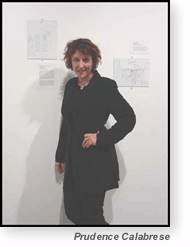 The Guggenheim Gallery at Chapman University is holding an unusual art exhibition titled, A Little Application of Our Much-Touted Know-How. Curated by artist Brian Tucker, the exhibit includes works that demonstrate unusual phenomena, featuring Remote Viewing works by HRVG, Dr. Angela Thompson Smith, and TDS.
The Guggenheim Gallery at Chapman University is holding an unusual art exhibition titled, A Little Application of Our Much-Touted Know-How. Curated by artist Brian Tucker, the exhibit includes works that demonstrate unusual phenomena, featuring Remote Viewing works by HRVG, Dr. Angela Thompson Smith, and TDS.
This is the first time that Remote Viewing sketches have been presented in a major gallery art show.
Four sketches from blind remote viewing sessions are shown along a short wall, one each from Dick Allgire of HRVG, Jim Karrlson of HRVG, Prudence Calabrese of TDS, and Cy Shinkawa of TDS.
Each of the sketches clearly depicts the scene of the intended objective and does not require any additional information or interpretation. Each sketch is matted and framed and accompanied by the written or photographic tasking disclosure. The four sketches represented in the gallery do not disappoint in artistic or scientific merit.
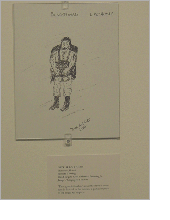 In a corner of the Remote Viewing exhibit is a television with a video presentation of Dr. Angela Thompson Smith giving a lecture at the 2001 IRVA Conference. Several scientific papers on Remote Viewing are placed on a small table, and visitors are encouraged to handle and read the reports. A large wall-mounted poster details a brief history of Remote Viewing with several definitions for the benefit of the audience. In a corner of the Remote Viewing exhibit is a television with a video presentation of Dr. Angela Thompson Smith giving a lecture at the 2001 IRVA Conference. Several scientific papers on Remote Viewing are placed on a small table, and visitors are encouraged to handle and read the reports. A large wall-mounted poster details a brief history of Remote Viewing with several definitions for the benefit of the audience.
The title of the exhibit comes from the writings of Richard S. Shaver (1907 - 1975), whose work makes up the largest portion of the show. Shaver was a science fiction writer whose stories told tales of a great race of advanced technological beings who once lived on Earth and encoded their history inside of rocks. Even though these stories were printed in the pulp magazine Amazing Stories, Shaver's fans believed them to be true.
Shaver spent years examining rocks, looking for evidence of this forgotten race. The exhibit includes drawings, paintings and photos that he made of these encoded rocks. They cover several walls, and detail tiny mermen from the sea and monsters and bare-breasted women. Some of the images are remarkable, and the average person can clearly see the outlines of these entities within the rocks. Other images require a bit of interpretation, provided by Shaver's hand-written notes.
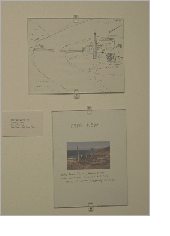 The gallery has devoted a corner of the exhibit to "Reverse Speech," a discovery of John David Oates, where he claims that people encode words in reverse in normal conversation. If you play recorded speech backwards, you can hear these words and phrases, and they tell you a speaker's unconscious motivations and thoughts. In the exhibit, several CD players are placed in a row on a table. The visitor can listen to audio segments of some famous people including President George W. Bush, and O.J. Simpson, where the speech is first placed forwards, and then in reverse. Oates narrates the segments and helps the listener understand the reversals. Like Shaver's work, some of the reversals are striking in their clarity and simplicity, and others require more effort and interpretation. The gallery has devoted a corner of the exhibit to "Reverse Speech," a discovery of John David Oates, where he claims that people encode words in reverse in normal conversation. If you play recorded speech backwards, you can hear these words and phrases, and they tell you a speaker's unconscious motivations and thoughts. In the exhibit, several CD players are placed in a row on a table. The visitor can listen to audio segments of some famous people including President George W. Bush, and O.J. Simpson, where the speech is first placed forwards, and then in reverse. Oates narrates the segments and helps the listener understand the reversals. Like Shaver's work, some of the reversals are striking in their clarity and simplicity, and others require more effort and interpretation.
The final segment of the exhibit displays photographs taken in the 1960s and '70s by the late Joseph Veilleux and his sons Richard and Fred. The Veilleux family started using a Ouija board and receiving messages from persons beyond the grave. These messages told the family to take photographs and make recorded tapes at certain times and places. The photographs are eerie, showing vaporous faces and ghostly shapes. No scientific research on the photographs is presented, leaving the visitor to wonder if these photographs had been scrutinized for hoaxing techniques such as double exposures.
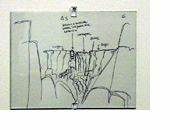 On February 25th, the gallery held an opening with a panel discussion, attended by 62 people. Rounding out the panel were curator Brian Tucker, Reverse Speech expert Terese Johnson, and professional skeptic and author Michael Shermer. On February 25th, the gallery held an opening with a panel discussion, attended by 62 people. Rounding out the panel were curator Brian Tucker, Reverse Speech expert Terese Johnson, and professional skeptic and author Michael Shermer.
Brian Tucker began by explaining that the show was intended to invite thought about the relationships between critical thinking, science, faith, and art. He then gave an overview of the exhibit and showed slides of some of the pieces in the gallery. He spent considerable time describing the life and activities of Richard Shaver as well as the Veilluex family. He briefly mentioned Remote Viewing, explaining that there were professional Remote Viewers in attendance who would be invited to speak following the discussion. He quickly showed several slides of work not shown in the gallery, including a Remote Viewing sketch of an older woman done by Glenn Wheaton of HRVG.
Terese Johnson followed with a lecture on Reverse Speech, complete with audio segments. She showed a lot of excitement and energy in presenting her work, and came across as likeable and genuine. This was Ms. Johnson's first lecture, and her inexperience and soft nature allowed Michael Shermer to take control of the lecture, demanding Ms. Johnson to replay certain segments so that he could re listen to them. Mr. Shermer used jokes and body language to get the audience laughing at Ms. Johnson's presentation, and he continued by providing a rapid diatribe on the non-merits of every piece of work in the exhibit.
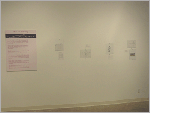 Mr. Shermer questioned the veracity of the Remote Viewing work, and playfully told a story of how he took training in Remote Viewing with Dr. Wayne Carr. He explained that humans are fundamentally pattern-seeking animals and that the training was truly in getting the students to look for patterns, not for real, objective data. He insinuated that striking results seen in the classroom were a result of collusion between teacher and student. Although this reviewer attempted to publicly correct some of the characterizations Mr. Shermer was making concerning the Remote Viewing work, he pointedly ignored the attempt. No questions or comments were allowed from the audience. Unfortunately, Mr. Shermer abruptly ended the presentation, and the discussion on Remote Viewing was not allowed to happen. There was no significant discussion on the intersection of unusual research and art. Guests moved to the gallery after the panel discussion and had refreshments while Mr. Shermer signed copies of his books. Mr. Shermer questioned the veracity of the Remote Viewing work, and playfully told a story of how he took training in Remote Viewing with Dr. Wayne Carr. He explained that humans are fundamentally pattern-seeking animals and that the training was truly in getting the students to look for patterns, not for real, objective data. He insinuated that striking results seen in the classroom were a result of collusion between teacher and student. Although this reviewer attempted to publicly correct some of the characterizations Mr. Shermer was making concerning the Remote Viewing work, he pointedly ignored the attempt. No questions or comments were allowed from the audience. Unfortunately, Mr. Shermer abruptly ended the presentation, and the discussion on Remote Viewing was not allowed to happen. There was no significant discussion on the intersection of unusual research and art. Guests moved to the gallery after the panel discussion and had refreshments while Mr. Shermer signed copies of his books.
On its own, the exhibit was a thoughtful and interesting interchange of unusual theories and research presented for artistic merits. Brian Tucker gathered striking and curious pieces of work for this show, and showed an open mind toward learning about new and unusual ideas. Most of the program attendees spend considerable time inspecting the work in the show, and many asked this reviewer questions about Remote Viewing and the people whose RV work was exhibited.
The Guggenheim Gallery at Chapman University, Orange, California. This exhibition is open Monday, February 18 through Friday, March 29, 2002. Gallery hours are, Monday through Friday, 12:00-5:00 and Saturday, 11:00-4:00. Closed Sundays. For further information, phone 714.997.6729.
New Online Art Gallery at Larger Universe
The Larger Universe web site has a new online Art Gallery. Remote Viewing is not only a way to travel the Universe as a psychic journalist, but can also be an amazing art generator. Sessions have incredible beauty in their sketches and language.
The new Art Gallery will present actual Remote Viewing sketches as well as art works, stories, and poems created by Remote Viewers. This ongoing exhibit is not about what "looks like" the objective/target. This is about translating meaning and understanding through the lens of the artist.
Currently the gallery is showing works done by four artists. Each of these works came from a Remote Viewing type of vision or experience and was translated onto the page by the artist.
The Larger Universe is happy to present work from all schools of Remote Viewing, and is actively seeking submissions for the gallery.
You can visit the Art Gallery at:
http://www.largeruniverse.com/gallery/
or
art@largeruniverse.com 
 PRINT THIS ARTICLE PRINT THIS ARTICLE
Privacy Statement
Copyright © 2002, H.R.V.G.
All rights reserved. |
 |
|
   JANUARY-FEBRUARY ARTICLES
JANUARY-FEBRUARY ARTICLES

·Tagging
Target Sketch
Target Photograph

·Beverly Jeagers

·Cassirer

·True Story

·RV and Art

·Jan Pilgenroeder

·Discussions on RV
|


